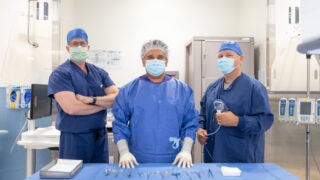Redefining Reality
USC researcher Mark Bolas pushes the boundaries of human-computer interaction with immersive technologies.
MARK Bolas draws an amoeba-like diagram on his whiteboard, sketching an org chart of the people in his lab with a squeaky marker. Undergrads and grad students from all over the university. Paid lab staff. Alumni. There’s even a category of people he calls “pre-students,” dabblers who are “trying things out” and might join USC later in one way or another.
There’s one group missing from the diagram: faculty. When a visitor points this out, Bolas, an associate professor himself, laughs sheepishly at his over-sight. Reflecting for a moment, he motions to the board. “I did forget faculty, because we’re working for these other people,” he explains. “Yes, we guide the research and have ways we want it to go, but these people are doing the research. That’s how we keep paying it forward.”
Bolas is a faculty member in USC’s School of Cinematic Arts and associate director of the university’s Institute for Creative Technologies, where his Mixed Reality (MxR) Lab pushes the boundaries of human-computer interaction and the open-source movement. His team creates new content and technologies that provide virtual experiences that are visceral and immersive, and then offers the blueprints for the creations for free.
One of his “pre-students” was a young virtual reality enthusiast named Palmer Luckey. Inspired by a research paper authored by the MxR team, Luckey visited the lab and, impressing Bolas, landed a spot on a team with other MxR students, programmers and professors.
Luckey, now 21, has since taken the tech world by storm with Oculus Rift, a virtual reality headset, and Facebook recently bought his company for $2 billion. Seeing Luckey’s success is a source of unqualified pleasure to Bolas. “I believe a big part of my job is helping to develop amazing people,” he says.
Bolas grew up in LA’s Echo Park neighborhood and traces his research philosophy and ?his successful career to a life-changing high school experience on the University Park Campus. Ditching his summer-school class on American government, he wandered around USC until he found an unlocked computer lab. He dug through the trash for a discarded password, logged into a computer and made himself at home. “That’s how I taught myself to code,”?he says, grinning.
Years later, as a Stanford mechanical engineering student, Bolas would again find a space to let loose his curiosity. His Stanford mentor, Scott Fisher—founding chair of the USC School of Cinematic Arts Interactive Media Division—was then head of the world’s first virtual reality lab, located at NASA’s Ames Research Center in Mountain View, Califorina.
“Scott said, ‘After 8 o’clock, when everybody leaves, this place is yours. Do whatever you want,’” Bolas recalls. “That became my thesis project.” Bolas helped create NASA’s prototype Virtual Environment Workstation, and he later founded Fakespace Labs, manufacturing virtual reality and interactive devices in the 1990s.
Today, Bolas makes sure that the MxR Lab’s doors are open ?to students of all backgrounds. Humanists, social scientists and artists “aren’t preoccupied with the limitations of technology,” he says. “We take technology, push it to the edge of its limitations and, hopefully, break it.”
To download free MxR projects, go to bit.ly/mxrfree.



